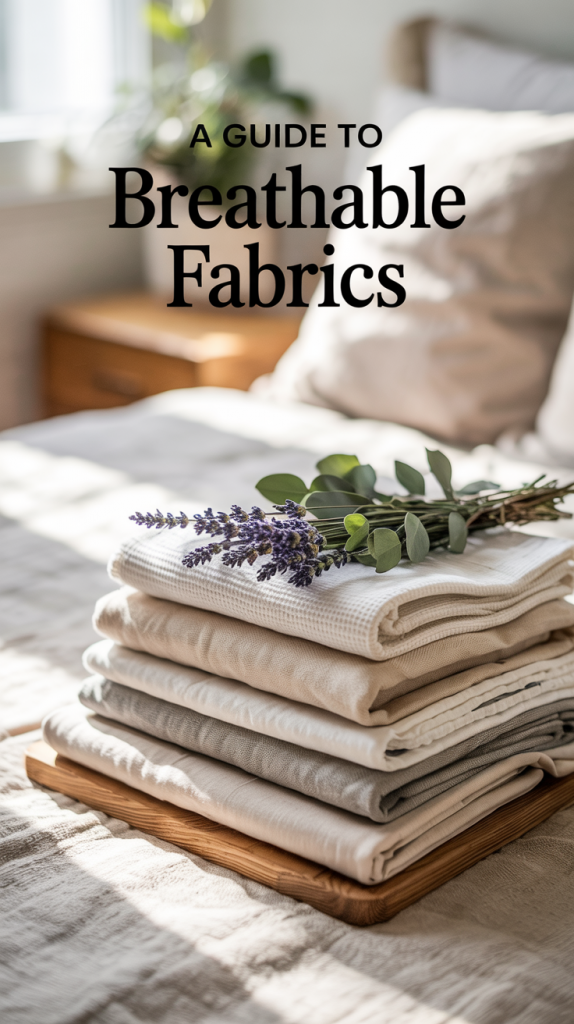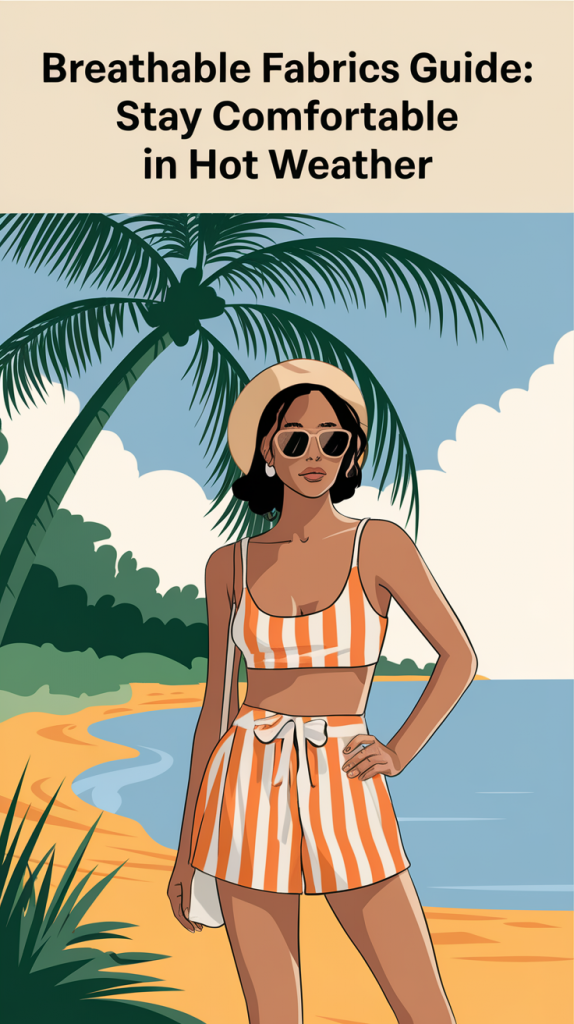Breathable Fabrics Guide: How to Stay Comfortable in the Heat of 2025
The United States will undergo elevated summer temperatures that will affect more than 60% of its population by 2025. External dress code affects our sensation while enduring high- or low-temperature environments. Our skin eagerly absorbs what we wear so the garments we wear beneath us matter much more than the typical person comprehends.
We specifically designed this information for anyone who has sweated through their outer garments in the morning. The following guide explains the most suitable breathable fabrics that maintain your physical comfort in hot weather conditions. The guide provides concrete recommendations about selecting breathable fabrics and outfits, along with recommending reliable brands.
The target audience group that will benefit from this guide includes?
- Anyone living in hot and humid U.S. states like Florida, Texas, or Arizona
- Commuters and outdoor workers
- Travelers, hikers, or anyone spending extended time outdoors
- Those who sweat easily or are sensitive to heat
Let’s dive into the world of breathable fabrics and help you beat the heat in style.

What Makes a Fabric Truly Breathable?
Understanding Airflow and Moisture Management
Breathable fabrics allow air to circulate through the material, helping heat and moisture escape from your body. This process reduces sweat buildup and keeps your skin dry and cool. But breathability isn’t just about feeling light—it’s about how efficiently a fabric can wick moisture away and promote ventilation.
Fabrics with loose weaves, natural fibers, or moisture-wicking technology excel in this area. They don’t trap heat or stick to your body.
Natural vs. Synthetic: The Big Debate
Natural fibers like cotton, linen, and bamboo are known for their breathability. But not all synthetic fabrics are bad—some, like polyester blends with moisture-wicking tech (think Nike’s Dri-FIT or Coolmax), perform surprisingly well.
So, what’s better: natural or synthetic? It depends on the situation. Natural fibers are ideal for everyday casual wear, while technical synthetic fabrics are perfect for workouts or active outdoor use.
Best Breathable Fabrics for Summer 2025
Cotton: The Everyday Champion
Cotton remains a staple for summer because it’s soft, breathable, and widely available. However, 100% cotton tends to retain moisture, so for super hot days, a cotton-linen or cotton-modal blend may be more effective.
Best for: Casual T-shirts, everyday shorts, lightweight dresses
Linen: Light, Airy, and On-Trend
Flax is the source of linen, which, thanks to its loose weave, offers exceptional breathability. It’s naturally moisture-wicking and dries quickly, making it a perfect choice for dry heat.
Best for: Button-up shirts, beachwear, tailored summer pants
Bamboo Viscose: Soft and Eco-Friendly
This rising star in sustainable fashion offers hypoallergenic and thermoregulating properties. It feels luxuriously soft and doesn’t cling to your skin.
Best for: Loungewear, undergarments, soft tees

Tencel (Lyocell): The Smart Modern Fiber
Made from wood pulp, Tencel is a silky, breathable fabric that’s often blended with cotton. It resists wrinkling and provides both structure and softness.
Best for: Workwear, summer dresses, chic button-ups
Moisture-Wicking Synthetics: Techwear for Hot Days
Brands like Under Armour, Reebok, and Lululemon use innovative weaves and finishes to make polyester blends that breathe and move moisture away from the body.
Best for: Workout gear, hiking outfits, intense outdoor activities
Comparison Table: Natural vs. Synthetic Breathable Fabrics
| Fabric Type | Breathability | Moisture Wicking | Drying Speed | Eco-Friendliness | Ideal For |
|---|---|---|---|---|---|
| Cotton | Medium | Low | Slow | High | Everyday wear |
| Linen | High | Medium | Fast | High | Dressy summer outfits |
| Bamboo Viscose | High | High | Medium | High | Loungewear, undergarments |
| Tencel | High | High | Medium | Medium | Workwear, office outfits |
| Polyester (Tech) | Medium-High | Very High | Very Fast | Low | Sports and workouts |
How to Choose Breathable Clothing: A Smart Shopper’s Guide
Read the Label
Always check the fabric content. Look for high percentages of natural fibers or advanced tech fabrics with wicking capabilities. If a shirt is labeled “polyester” without additional moisture-wicking features, skip it for hot weather.
Feel the Fabric
Breathable fabrics typically have a cool feel to the touch and do not cling. Avoid overly shiny or rubbery finishes—they usually trap heat.
Consider the Weave and Fit
Looser weaves allow more airflow. Furthermore, relaxed or flowy fits help circulation and minimize contact with the skin. Think loose linen shirts or wide-leg cotton trousers.

Checklist for Buying Summer Clothing:
Which Brands to Trust for Breathable Clothing in the U.S.?
Budget-Friendly Picks
- Uniqlo – AIRism collection with moisture-wicking tees
- Old Navy – Cotton-linen blends, breezy summer dresses
- Amazon Essentials – Basic 100% cotton tees and tanks
Sustainable and Stylish
- Everlane – Organic cotton and linen blends
- tentree – Tencel and eco-viscose clothing with carbon offsetting
- Patagonia – Technical outdoor clothing with ethical production
Performance and Sports
- Nike – Dri-FIT breathable T-shirts and running shorts
- Under Armour – HeatGear and Iso-Chill fabrics
- Lululemon – Lightweight, wicking workout tops
Caring for Breathable Fabrics: Tips to Prolong Life and Comfort
Proper care extends the life of your clothes and keeps their breathable properties intact.
Tips for All Fabrics:
- Wash in cool water to preserve fibers
- Avoid fabric softeners (they can clog weaves)
- Line dry when possible
- Use gentle detergents without heavy fragrances
Special Note: Linen and bamboo fabrics wrinkle easily—steam instead of iron for best results.
What’s New in Breathable Fabric Tech for 2025?
Fabric innovation is booming in 2025. Tech-forward brands are experimenting with phase-change materials (PCMs) that actively cool your skin and biodegradable fibers with micro-ventilation.
Emerging innovations:
- Smart fabrics that adjust airflow based on humidity levels
- Plant-based synthetics that biodegrade faster
- UV-blocking materials for dual heat and sun protection
Expect to see these materials popping up in everything from activewear to travel-friendly shirts.
Key Takeaways: How to Stay Cool, Dry, and Stylish
Here’s what you should remember:
- Breathability depends on fiber, weave, and finish—choose wisely.
- Cotton is good, but not always the best—especially when soaked.
- Linen, bamboo, and Tencel offer serious summer comfort.
- Technical synthetics are your friend for high activity and workouts.
- Fit, color, and care all affect how comfortable your clothes feel.

